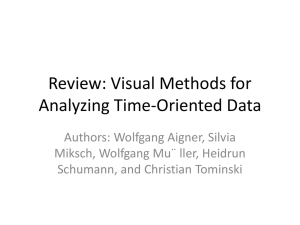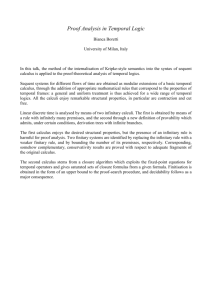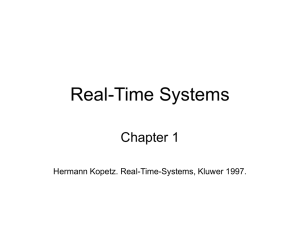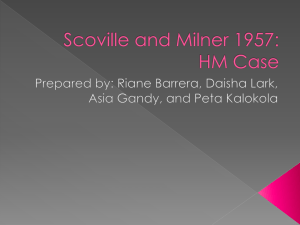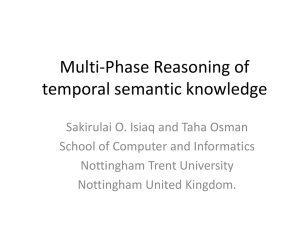doc - University of Southern California
advertisement
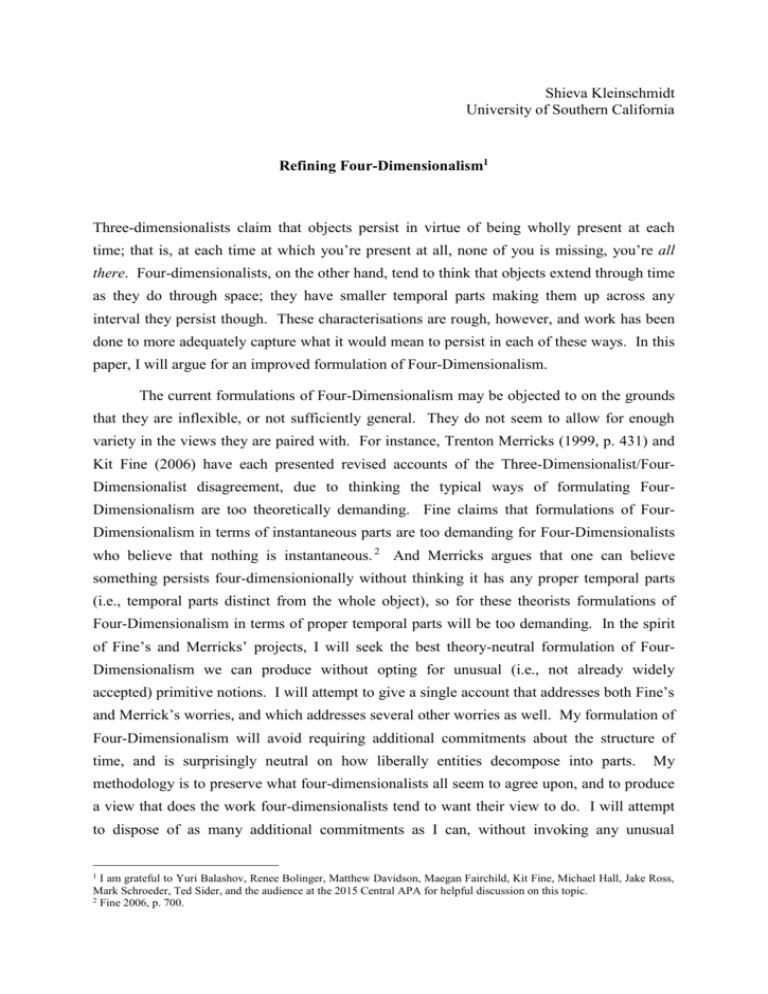
Shieva Kleinschmidt University of Southern California Refining Four-Dimensionalism1 Three-dimensionalists claim that objects persist in virtue of being wholly present at each time; that is, at each time at which you’re present at all, none of you is missing, you’re all there. Four-dimensionalists, on the other hand, tend to think that objects extend through time as they do through space; they have smaller temporal parts making them up across any interval they persist though. These characterisations are rough, however, and work has been done to more adequately capture what it would mean to persist in each of these ways. In this paper, I will argue for an improved formulation of Four-Dimensionalism. The current formulations of Four-Dimensionalism may be objected to on the grounds that they are inflexible, or not sufficiently general. They do not seem to allow for enough variety in the views they are paired with. For instance, Trenton Merricks (1999, p. 431) and Kit Fine (2006) have each presented revised accounts of the Three-Dimensionalist/FourDimensionalist disagreement, due to thinking the typical ways of formulating FourDimensionalism are too theoretically demanding. Fine claims that formulations of FourDimensionalism in terms of instantaneous parts are too demanding for Four-Dimensionalists who believe that nothing is instantaneous. 2 And Merricks argues that one can believe something persists four-dimensionionally without thinking it has any proper temporal parts (i.e., temporal parts distinct from the whole object), so for these theorists formulations of Four-Dimensionalism in terms of proper temporal parts will be too demanding. In the spirit of Fine’s and Merricks’ projects, I will seek the best theory-neutral formulation of FourDimensionalism we can produce without opting for unusual (i.e., not already widely accepted) primitive notions. I will attempt to give a single account that addresses both Fine’s and Merrick’s worries, and which addresses several other worries as well. My formulation of Four-Dimensionalism will avoid requiring additional commitments about the structure of time, and is surprisingly neutral on how liberally entities decompose into parts. My methodology is to preserve what four-dimensionalists all seem to agree upon, and to produce a view that does the work four-dimensionalists tend to want their view to do. I will attempt to dispose of as many additional commitments as I can, without invoking any unusual 1 I am grateful to Yuri Balashov, Renee Bolinger, Matthew Davidson, Maegan Fairchild, Kit Fine, Michael Hall, Jake Ross, Mark Schroeder, Ted Sider, and the audience at the 2015 Central APA for helpful discussion on this topic. 2 Fine 2006, p. 700. 2 primitive notions. We will be left with a formulation of Four-Dimensionalism that is harder to object to than its more commitment-laden counterparts, and that also sheds light on what is really at stake when we debate about whether things persist four-dimensionally.3 This paper will proceed as follows: I will begin by broadly setting apart ThreeDimensionalism, Four-Dimensionalism, and the Spanning View of persistence. I will then work through a series of formulations of Four-Dimensionalism, showing problems with each formulation, and how each problem might be addressed. Finally, I will conclude with my own account. 1. An Overview of Views of Persistence First, let’s do some quick dividing up of views about persistence. There are two main alternatives to four-dimensional persistence that have been discussed: Three-Dimensionalism and The Spanning View4. Attempts have been made to characterise Three-Dimensionalism mereologically (i.e., in terms of part-whole relations). For instance, it is tempting to take Three-Dimensionalism to be the claim that persisting objects lack proper temporal parts (temporal parts that are distinct from the whole).5 However, this has been objected to.6 For it seems that a threedimensionally persisting object could have temporary temporal parts: an object can be wholly present at each time, but made up of something different (and temporary) at each time, such as a statue made up of a different portion of clay at each instant. Though we may think that there are problems with a view like this, it does not seem contrary to the spirit of ThreeDimensionalism for things to be this way. So the most straightforward mereological account does not seem to get at what we have in mind with three-dimensional persistence. In fact, elsewhere I have argued that every way of attempting to give a mereological formulation of Three-Dimensionalism will fail (see Kleinschmidt, Unpublished). However, we have alternatives. For instance, we might follow Peter van Inwagen in claiming that ordinary objects that persist are nonetheless temporally unextended.7 We might say that this is so 3 You may believe that there is something central to Four-Dimensionalism that my formulation leaves out. For instance, you may believe that Four-Dimensionalism includes a claim about grounding, or what persistence is in virtue of. In this case, you are welcome to read this paper as an attempt at clarifying (and simplifying the commitments of) the mereological component of Four-Dimensionalism. 4 I am not aware of anyone who takes the Spanning View to be a genuine contender for how things persist. However, Cody Gilmore (unpublished) has shown that the view is relevant to how we draw distinctions between alternative views of persistence. 5 See, for instance, Markosian 1994. 6 See, for instance, Fine 2006, and Hawthorne 2006. 7 See van Inwagen 1990. 3 because material, three-dimensionally persisting objects are wholly located8 at a temporally unextended spatial region at each time at which they are present.9 The regions at which the entities are located will not be temporally extended, though our theorist will be free to say entities persist across extended temporal intervals. Alternatively, we could separate talk of size from talk of where entities are located. We can simply cash out the view in terms of temporal sizes of persisting objects; though one might say that objects are present across extended intervals of time, their shapes are not extended in the temporal dimension. Finally, we might follow Kit Fine (2006) in saying that objects persist three-dimensionally if they exist (henceforth: existFine) in time but are not located in it.10 The second alternative to Four-Dimensionalism is The Spanning View. On this view, persisting objects span11 extended temporal intervals, but have no parts (proper or otherwise) located or existingFine within proper subintervals of those intervals. For example, suppose we have an object that is spatially simple and temporally extended, such as a (spatially) pointsized grain with a minute-long life. If this object persists via spanning, then though it fills a minute-long interval, it is neither located at nor existsFine within any shorter portion of that minute, nor does it have any parts with either of those features. Whereas a three-dimensional object is located at or existsFine at each time at which it’s present, and a four-dimensional object tends to have temporal parts present at times at which it is present, a persisting spanner will fill an extended temporal region, and bear a location (or existence Fine) relation to that region, without it or any part of it being located at or existing at shorter intervals within that region. Suppose for the moment that the spanning theorist believes that spanners are located at the temporally extended regions they occupy. (So, in the case of the grain, the object will be located at a minute-long interval. Let’s call such objects ‘spannersL’.) If we endorse this view (perhaps because we don’t posit an notion of existenceFine), then we will take The 8 Throughout this paper, I will talk of being located at a time, or located at an interval of time. By this, I mean that the entity is located at a region that overlaps with every subinterval of that time or interval of time, and does not overlap with any intervals disjoint from that time or interval of time. Further, we are free to read my talk of times as being relative to reference frames. 9 See, for instance, Simons 1987 and Hawthorne 2006. For more references, see Sider 2001, p. 63. For an excellent discussion of how to define wholly present, as well as a survey of attempted definitions, see Crisp and Smith 2005. And if we wish to combine Three-Dimensionalism with gunky time, we can amend our formulation to say “persisting objects are wholly located in every time at which they are present.” 10 I tend to prefer the locative account because it does not require an extra primitive relation beyond what the ThreeDimensionalist’s opponent already (barring Supersubstantivalism) has reasons to posit. Though Kit Fine’s view has the advantage that it gives us a unified account of three-dimensional persistence for material objects and (if there are any) immaterial objects present in time (which, arguably, wouldn’t have sizes or locations, but may nonetheless exist in time; see Fine 2006 for other advantages). But we won’t need to take a stand on this topic here. We need something that sets ThreeDimensionalism apart from the other views, but regardless of our take on what this should be, there is work to be done in separating Four-Dimensionalism from The Spanning View. 11 The term ‘spanner’ was first used by Kris McDaniel (2003), to name a sort of entity that Cody Gilmore first presented to the literature and described in his dissertation in 2004. For further discussion, see Hudson 2006, pp. 99-103. 4 Spanning View and Four-Dimensionalism to have a lot in common. We will not be able to characterize The Spanning View merely via appeal to location, size, or existenceFine in time, because the spanning theorist agrees with the four-dimensionalist about all of these things: they agree about where persisting objects are located, what their sizes are, and whether they existFine in time. Both theorists think that persisting objects are located at regions that are temporally extended (and, unless they endorse some nonstandard view, they think the objects have the same sizes and shapes as the regions at which they are located). The crucial difference seems to be mereological: four-dimensionalists take persisting objects to have parts that bear particular relations to regions, and the spanning theorist denies that persisting objects have such parts. So, to set the Spanning View and Four-Dimensionalism apart from one another, it seems we should appeal to mereological features. Suppose, though, that we follow Fine in claiming that three-dimensionally persisting objects existFine in time and four-dimensionally persisting objects don’t. In this case, one may initially be tempted to think we could use the notion of existenceFine to help us set spanning apart from four-dimensional persistence as well. The idea is this12: we should take threedimensionally persisting objects to existFine at each time at which they are present, spanning objects to existFine at the temporal intervals they fill but not at any of their proper subintervals, and four-dimensionally persisting objects to not existFine at any times, but instead to be located in time. I worry about this way of dividing the views, however. For consider someone who believes things persist by spanningL: they think anything that persists through time is located at a temporally extended region, without having any more temporary parts within that region. On Fine’s way of dividing up views, we have two options. Our first is to take the SpanningL View to be a kind of Four-Dimensionalism, on account of it entailing that all persisting entities are located in time. But four-dimensionalists are likely to balk at this: being located at temporally extended regions is just one crucial component of fourdimensional persistence. Possession of temporary proper parts is an equally crucial component, and serves as the basis for the four-dimensionalist’s response to several puzzles in Metaphysics. To categorize the SpanningL View as Four-Dimensionalist is to miss a crucial component of the spirit of the view. The Finean’s second option with respect to the SpanningL View is to claim that it is not among the coherent alternative views of persistence. Perhaps this can be done by claiming that the notion of location in time requires that anything located at a temporally extended region has temporary parts. If we opt for this response, we should say more about precisely how mereologically demanding this requirement is. What sorts of temporary parts are required? How liberally must our persisting entities decompose 12 Thank you to ---- for bringing this to my attention. 5 into parts?13 These are exactly the sorts of requirements I am attempting to make clear in this paper. I am taking the requirements to be contained in our formulation of Four- Dimensionalism, but one is welcome to instead take them to follow instead from the notion of location in time. What is important is becoming clear on exactly what those requirements are. Thus, though we can distinguish Three-Dimensionalism from each of FourDimensionalism and the Spanning View merely via appeal to location, size, or existenceFine in time, we must appeal to something else to distinguish Four-Dimensionalism from the Spanning View. Plausibly, we should appeal to mereological features: persisting, spanning objects lack some parts that their four-dimensional counterparts have. The four-dimensionalist, then, seems to disagree with the spanning theorist about which sorts of parts persisting objects have, and to disagree with the three-dimensionalist about where (or whether) persisting objects are located in time, or what sizes they have. Roughly: the four-dimensionalist thinks that, for any persisting object: it has proper parts present at (and contained within) proper temporal subregions of the region it occupies. Further, the persisting object is the fusion of those proper parts, and occupies the fusion of the regions occupied by those proper parts.14 (I will include a fusion condition like this one in the formulations of Four-Dimensionalism that I will consider below, putting it in italics when adding it to a formulation presented by someone else.) This characterisation of FourDimensionalism is incomplete, however, because it does not tell us enough about which parts four-dimensional objects must have.15 It is to that issue that we shall now turn. 2. Formulating Four-Dimensionalism Standardly, it is believed that four-dimensionally persisting objects must have proper temporal parts.16 Ted Sider (2001) gives us the following account of temporal parts: 13 x is an instantaneous temporal part of y at instant t =df (i) x is a part of y; (ii) x is present at, but only at, t; and (iii) for all z, if z is present at, but only at, t, and z is a part of y, then x overlaps z.17 For instance, the mere requirement that an entity have at least one temporary proper part will not be sufficient. (Consider, for instance, an hour-long individual that divides into two half-hour long spanners.) 14 Things are more complicated if you think four-dimensional objects or their parts can be multiply located. For a discussion of this, see ---. 15 We might also say that it is incomplete because it does not say anything about what it is in virtue of that persistence occurs. Please feel free to add this to my formulations if you would like. 16 These can be contrasted with temporary proper parts, which I will discuss shortly. 17 I have substituted talk of presence at times for Sider’s talk of existence at times, just to avoid any confusion that this might require a denial of Eternalism, the view that past, present, and future objects all exist. Thomson (1983, p. 207) offers a slightly different account of temporal parts, on which, roughly, x is a temporal part of y at T iff x is located at the intersection of T and y’s location. Four-Dimensionalism when understood as involving temporal parts as defined by Thomson will face 6 The first condition ensures that x stands in the right mereological relation to y, and that x does not contain too much; if x is part of y, x cannot have any parts that y does not also have. The second condition ensures that x is exactly the right temporal size. The third ensures that x contains enough; none of y escapes it at the times at which x is temporally present. Using this definition, Four-Dimensionalism is formulated. (Note: I have included my additional 18 requirement in italics. ) Four-Dimensionalism1: Necessarily, each spatiotemporal object has a temporal part at every moment at which it is present19 (and is the fusion of all of its temporal parts). It is worth noting that this is a general formulation of Four-Dimensionalism, intended to cover both the Worm View (on which ordinary objects are temporally extended) and Stage Theory (on which ordinary objects do not persist 20 . Though those two kinds of FourDimensionalism disagree about whether ordinary objects persist, they agree about what is involved in persistence. However, this formulation will be unacceptable for anyone who believes there are no instants, or non-extended units, of time. For such a person will count as a four- dimensionalist regardless of his or her other views, simply because the condition will be vacuously satisfied. Thus, Sider provides an alternative account for those who think that time comes only in extended chunks: x is an extended temporal part of y at temporal interval T =df (i) x is a part of y; (ii) x is present at, but only at, times in T; and (iii) for all z, if z is present at some time in T, and is not present at any time not in T, and if z is a part of y, then x overlaps z. And: Four-Dimensionalism2: Necessarily, each spatiotemporal object has a temporal part at every relevant temporal interval it persists through (and is the fusion of all of its temporal parts).21 If we take ‘interval’ to simply mean ‘region of time’ so it includes instants as well as extended temporal regions, the above definition of ‘extended temporal part’ can instead serve as a general definition of ‘temporal part’, capturing extended as well as unextended temporal parts. And Four-Dimensionalism2 will provide us with an informative condition regardless of the same problems that I will raise for Four-Dimensionalism involving temporal parts as defined by Sider. For interesting further problems facing these accounts of temporal parts, see Effingham 2011. 18 To motivate this condition, recall the three-dimensionally persisting statue that is made of a distinct, instantaneous chunk of clay at each time. Arguably, this statue has temporal parts at each time. But with the added requirement that fourdimensionally persisting objects fuse all of their proper temporal parts, we avoid classifying this statue as a fourdimensionally persisting object. 19 Again, I’ve replaced talk of existence with presence. 20 See Sider 2001. 21 Sider 2001, p. 60. 7 our view of the structure of time; that is, regardless of whether we think time is pointy, consisting of infinitely many instants, chunky, consisting of smallest extended regions of time, or gunky, consisting of smaller and smaller extended intervals and no instants. However, the formulation is useless to us until we have some idea of what is meant by relevant temporal interval. Sider suggests that the relevant intervals are the continuous ones. Thus: Four-Dimensionalism3: Necessarily, each spatiotemporal object has a temporal part at every continuous temporal interval it persists through (and is the fusion of all of its temporal parts). This principle will entail not only that a temporally extended object will have temporal parts at all of the smallest temporal regions it persists through (if there are any such regions), but that for any continuous temporal region, if our entity persists through it, it has a part exactly there (that is, importantly: a temporal part not simply contained within the region, but is exactly at it. It is present at every time within the interval, and at no times that do not overlap the interval). So we each have a temporal part that extends through, say, just the first half of the our lifespan, and another extending through all but our last minute and forty-seven seconds.22 This requires a sort of liberal decomposition that many may find distasteful. It is relevantly similar to the Doctrine of Arbitrary Undetached Parts. Formulated (but not endorsed) by Peter van Inwagen, this doctrine says: The Doctrine of Arbitrary Undetached Parts (DAUP): For every material object, M, if R is the region of space occupied by M at time t, and if sub-R is any occupiable sub-region of R whatever, there exists a material object that occupies the region sub-R at t.23 It is not unreasonable to want to reject DAUP. While it is natural to think that you have hands, arms, a torso, etc., it is less natural to think there is a single part consisting of all of you but the portions within an inch of where your feet meet the floor.24 If we reject DAUP for spatial parts, we may also wish to reject the relevantly similar claim about temporal parts John Hawthorne (2006, p. 87) formulates an even more demanding thesis for gunk theorists: “Gunky Plenitude: For any object x and any temporal interval of non-zero measure during which x exists, there is an object y such that y exists just in the interval and coincides with x at every time in the interval.” This requires then gunk theorist to posit even more objects than Four-Dimensionalism3 would require of them (since it requires objects at discontinuous intervals as well), but it does not require that these objects are parts of the persisting object. 23 van Inwagen 1981. 24 Mark Heller notes that one can reject DAUP while accepting Four-Dimensionalism, on p. 327 of his (1984). Many accept DAUP because they accept that objects have point-sized parts at every point at which they are present, and they accept Unrestricted Composition. But the Unrestricted Composition theorist has some work to do: see Dan Korman’s “Debunking Perceptual Beliefs About Ordinary Objects” for an interesting challenge to some widely endorsed motivation for Unrestricted Compositon. 22 8 – especially if, as four-dimensionalists are often fond of saying, objects are spread across time in the same way they are spread across space. Rejecting this form of liberal decomposition should not be incompatible with accepting Four-Dimensionalism.25 So, there must be a less demanding formulation of the view. If we were considering only views on which there are simple temporal intervals (that is, either instants or extended temporal intervals that are not made up of any smaller temporal regions), we might give the following formulation (and, having moved past Sider’s formulations, I will replace quantification over spatiotemporal objects with quantification over persisting objects, to allow for four-dimensionalists who do not believe in spacetime, and I will include my additional condition without italics): Four-Dimensionalism4: Necessarily, each persisting object has a temporal part at every mereologically simple temporal interval it persists through, and is the fusion of all of its temporal parts. Using this formulation, someone who believes that time is pointy will count as a fourdimensionalist as long as she thinks that persisting objects have temporal parts at every instant at which they are present. It does not matter if she also thinks there are temporal parts present at any extended intervals through which the object persists. This formulation, then, will have the same results for our pointy theorist as Sider’s original formulation. Similarly, if one takes time to be chunky, then as long as entities are taken to have temporal parts at each of the smallest intervals through which they persist, the entities will count as persisting fourdimensionally regardless of whether they have any larger temporal parts. However, even if we believe this account is successful in avoiding being too demanding with respect to how liberally entities must decompose into parts, it has the same problem as Four-Dimensionalism1. It is not a plausible formulation of Four-Dimensionalism regardless of our view of the structure of time, for it fails to allow for the view on which time is gunky. For someone who believes time is gunky will think there are no mereologically simple temporal intervals. So, according to the above formulation, every object persisting through a temporally gunky interval will count as persisting four-dimensionally (even spanning objects and three-dimensional objects). What we want, then, is a formulation of Four-Dimensionalism that applies to gunky time as well as to non-gunky time, and which does not carry hefty commitments to views like DAUP. An initial attempt: 25 Kit Fine (2006, p. 700) also takes a stand against grouping claims of liberal decomposition with Four-Dimensionalism. He comes to a different conclusion than I do, though: this is one of his motivators for positing two different ways of being present in time: persisting through it, and existing in it. 9 Four-Dimensionalism5: Necessarily, each persisting object is such that (i) every temporal interval it persists through is wholly decomposable into sub-intervals, the Ts, that have temporal parts of the object at each of their sub-intervals, and (ii) it is the fusion of all of its temporal parts. That is to say: for any interval an object persists through, there is some level of decomposition of that interval into smaller intervals, and from that group of smaller intervals on down, we find temporal parts of our object at each of those times. If we think time is wholly decomposable into simple (instantaneous or extended) intervals, the most minimal way to satisfy this requirement will be to simply have proper temporal parts at each simple interval. For the gunk theorist, things are a bit messier. We need simply that there is some level of decomposition with this feature, where, while above it there may be temporal intervals not exactly occupied (in the sense described earlier, where the object is present at every time within the interval and does not spill out of it) by one of our object’s temporal parts, below it we never find such unoccupied temporal intervals. But unlike our pointy- or chunky-time theorists, our gunky-time theorist does not have a nonarbitrary way to select the level of decomposition that has this feature. If we want to restrict an object’s decomposition into temporal parts, our temporal gunk cannot be uniform, and we have no way to explain the difference in our gunk across levels of decomposition. Consider how this formulation of Four-Dimensionalism mischaracterizes the following case of uniform temporal gunk: Intermittent Temporal Gunk: Object O is extended for one hour of gunky time. O does not have proper temporal parts exactly occupying either the first half or second half of that hour, but it does have proper temporal parts exactly occupying each fourth of the hour. And it does not have temporal parts at any of the eighths of its duration, but it does have temporal parts at each of the sixteenths. And so on, ad infinitum. This object persists in virtue of having proper temporal parts present at different times at which it is present. But it will not meet the requirement in Four-Dimensionalism5 because, for any decomposition of the hour into subintervals, the Ts, that we choose, there will be some subinterval of some member of the Ts at which the object does not have a temporal part. (That is, though it may have parts contained in such an interval, it does not have a temporal part with the same duration as that interval, present at each time within the interval and not present outside of it.) This is so because, for any interval we choose, if it has a temporal part of our object at it, then the first and second halves of that interval do not have temporal parts of our objects exactly at them (though they overlap with temporal parts of our object, and contain temporal parts of our object). If we want to claim that an object like this one can count as four-dimensional, as well as avoid the arbitrariness our most recent 10 formulation requires of the gunk theorist, we need an alternative account. We may opt instead for the following. Four-Dimensionalism6: Necessarily, each persisting object is such that, (i) every interval26 it persists through is wholly decomposable into subintervals at which the object has a temporal part, and (ii) the object is the fusion of all of its temporal parts. This formulation tells us that, for any persisting entity and any interval it persists through, anywhere we look within the interval, we’ll find the entity has temporal parts throughout it. Pointy and chunky objects can meet the requirement by simply having temporal parts at each (pointy or extended) simple temporal interval. And gunky objects can meet the requirement even with an unusual distribution of temporal parts “all the way down”. All that is required is this: no object can persist through a temporal region without having temporal parts that make it up throughout that interval. Thus, we have a straightforward formulation of Four-Dimensionalism that seems to highlight what it is to persist four-dimensionally, while avoiding needless commitments about the structure of time, and while avoiding needless commitments to extra parts of our persisting objects. This formulation looks promising. However, there is an issue to address. One of our desiderata is to minimise mereological commitments, but it is widely granted that to endorse Four-Dimensionalism, you cannot be completely mereologically neutral. It is assumed that you must at least claim that persisting objects have proper temporal parts. However, Trenton Merricks (1999) has questioned this. He has claimed that things can persist four-dimensionally without having proper temporal parts. To see how we might get such a result, consider the following, highly unusual view (a bit different from what Merricks presents): Combine a van Inwagenesque Ontology with a spacetime-worm view of persisting objects. That is, suppose we think that the only objects that exist are mereological simples (such as instantaneous point-sized grains, for instance) and living beings (such as people and dogs). But suppose we also think that objects that persist are not wholly located at any given instant, but instead are located at the fusion of all of the regions they fill. Thus, on this view, I am not wholly present right now, nor do I have a temporal part that is present right now. The only parts of me that are entirely present right now are point-sized, instantaneous simples. And yet, though we have fewer objects to work with than a typical four- dimensionalist does, this seems like a four-dimensionalist view, because the entity persists 26 I want to emphasise that I do not just mean for this to describe merely the largest interval the entity persists through. This condition applies to any interval whatsoever that the thing fills; so, for instance, it applies to the first minute of your life, as well as the full interval your life fills. And it applies to the first second of that first minute. And so on. 11 across time via having proper parts contained within each of the extended temporal regions it fills (and being the fusion of all of those parts). This is a kind of Four-Dimensionalism without proper temporal parts.27 This view is odd, and (to my knowledge) has never been endorsed. (Though it does have some things to recommend it. For instance, the view can be used to respond to puzzles in Metaphysics in much the same way typical varieties of Four-Dimensionalism can, with pluralities of temporary parts playing the roles that temporal parts typically play. Further, the view may help us avoid The Problem of Thinking (proper) Parts, which typical varieties of Four-Dimensionalism have more trouble with.28 That, however, is a topic for another paper.) What matters for our purposes, though, is that, though this view does not posit any proper temporal parts, it seems to be squarely in the spirit of Four-Dimensionalism with respect to persistence across time. And our current formulation of Four-Dimensionalism says otherwise: it will classify this sort of persistence as relevantly dissimilar from fourdimensional persistence. So, how might we formulate Four-Dimensionalism in order to group this view with the others? We might attempt to merely state general requirements for parts persisting objects have, rather than having requirements for temporal parts in particular. For instance, we might go with the following formulation. Four-Dimensionalism7: Necessarily, each persisting object is such that, (i) every proper subregion of any region at which it is located is wholly decomposable into regions at which it has a proper part29, and (ii) it is the fusion of every object that is, at any time, part of it.30 This formulation has multiple problems, though. 31 The most significant is this: this formulation will misclassify some views on which things persist across time differently from how they persist across space. For instance, it misclassifies four-dimensional persistence of 27 The situation Merricks has us consider is slightly different: he has us imagine that everything is made up of fourdimensional cells which have temporal parts, but that the objects with the cells as proper parts do not have any additional, intermediate parts. So the composites of multiple cells do not have proper temporal parts, though parts of them have proper temporal parts. I’ve gone a different route simply because, on the view I’ve presented, no objects have proper temporal parts. So not only needn’t an object possess proper temporal parts for it to persist four-dimensionally, nothing in its world needs to have proper temporal parts, either. 28 For a presentation of this problem, see Olson 2007 pp. 78-98. The basic idea is this: It seems that the four-dimensionalist must accept the rather odd claim that, in addition to you thinking your thoughts, something distinct from you, say, your minute-long current temporal part, also thinks some of your thoughts. On the view I’ve presented, all of the proper parts of thinking creatures are too simple to think themselves. 29 This portion of the account is in some ways similar to Hudson’s account of pretension (Hudson 2006): ‘x pertends’ =df x is a material object, and x is entirely located at a non-point-sized region, r, and for each proper subregion of r, r*, x has a proper part entirely located at r*. But, importantly: pertension requires that objects obey DAUP, and my four-dimensional persistence does not. 30 Sider (2001) talks about interpreting ‘y is part of x at t’ to mean y has a temporal part at t that is part of x. I do not intend to pick out such a relation with my “at a time, x is part of y”. I intend the ordinary requirements for parthood to apply. So, for instance, there are no parts of y that are not also parts of x. 31 Some problems: It has difficulties with mixtures of Four-Dimensionalism and multiple-location, where an object bears the located at relation to more than one region (though issues of spatiotemporal multilocation raise enough problems that I leave discussion of this for another paper). And it may misclassify some three-dimensional objects that do not change their parts across time (though this could be avoided with the addition of some additional requirements). 12 some objects that are temporally extended, spatially extended, and spatially simple. Suppose a theorist thinks that the smallest objects are of Planck-length in each spatial direction, and that they persist by having temporal parts present at each time at which they are present at all. (Suppose also that space and time are made of continuously many points.) This theorist will not think that things persist through time in the same way that they persist through space; they can be spread across space without having proper parts within the extended spatial region, but they cannot be spread across time without having proper parts within the extended temporal region. On the above formulation of Four-Dimensionalism, space and time are treated on a par; we simply make a requirement of persistence across regions, and it applies to spatial regions, temporal regions, and spatiotemporal regions. This is a requirement that our persisting, extended, Planck-length, spatially-simple object will fail to meet, for the left half of the n-dimensional Planck-length region it fills at an instant is a proper subregion of a region at which it is located, but the object does not have any parts located at that region (though it fills that region). If we think that this object should count as persisting fourdimensionally, we need to revise our formulation of Four-Dimensionalism.32 If we want our requirements about parts to only apply to persistence across temporal intervals, but we do not want to require the existence of temporal parts, we might talk about pluralities of parts had at times rather than individual parts had at times. We might present something along these lines: Four-Dimensionalism8: Necessarily, for any persisting object, x, (i) every temporal interval x persists through is wholly decomposable into subintervals at which x has a part33, and (ii) x is the fusion of every object that is, at any time, part of it. More precisely, we might give this as the second condition: for any way of decomposing the fusion of intervals x fills into subintervals, the Ts, such that for each member of the Ts there is a part of x that fills that interval and does not spill out of it, there is some collection of objects, the ys, such that (a) each of the ys fills but does not spill out of some member of the Ts, (b) each of the Ts has at least one of the ys at it, and (c) x is a fusion of the ys. Here is the intuitive idea: This formulation requires that persisting entities have temporary parts, but not that they have temporal parts. Entities persist by having a succession of short-lived parts, and they fuse all of the parts they have at any time. 32 It should be noted that this object would not count as persisting four-dimensionally relative to every reference frame. However, we can imagine a theorist who posits objects such as these and believes (perhaps for moving spotlight purposes) that there is a privileged reference frame. All else being equal, it would be better for our formulation of FourDimensionalism to allow for such views, and not presuppose that a privileged reference frame does not exist. 33 I.e., at each of these subintervals, there is at least one part of the persisting object that fills the interval but does not spill out of it. 13 There is one final worry that I will discuss.34 One might hold the view that objects and times have mismatches in mereological structure. Suppose, for instance, a theorist thinks objects persist in virtue of having successions of instantaneous temporal parts, but he/she also thinks that time is gunky. If this theorist thinks that some persisting object does not have any intermediate-level temporal parts (there are just the instantaneous temporal parts, and the whole object), there will be no proper sub-intervals of the interval the object persists through at which the entity has a temporal part. The object will have many temporal parts in those intervals, but none at them. Perhaps, then, we can amend our account one last time, to require parts within intervals. Perhaps we should say: Four-Dimensionalism9: Necessarily, for any persisting object, x, (i) every interval x persists through contains a part of x35, and (ii) x is the fusion of every object that is, at any time, part of it. Again, the second condition should be understood as this: for any way of decomposing the fusion of intervals x fills36 into subintervals, the Ts, such that for each member of the Ts there is a part of x that is contained within it, there is some collection of objects, the ys, such that (a) each of the ys is contained within some member of the Ts, (b) each of the Ts has at least one of the ys contained within it, and (c) x is a fusion of the ys. Note that in shifting from talk of parts at intervals to talk of parts in intervals, we have a much easier response to worries about times made of instants vs. times made of gunk; we no longer need to talk of levels of decomposition, as the same requirement applies to every temporal region the entity is present at or through. Even if you think that the view on which there is a mismatch between the mereological structure of some persisting object and the mereological structure of the region it is located at is not one we need to be careful to allow for, it seems that we have lost nothing in amending our account of Four-Dimensionalism in order to do so. This last formulation of Four-Dimensionalism seems to capture the spirit of the view. It is my hope that this gives us some insight into what is actually required for this sort of persistence – and, perhaps, shows us that Four-Dimensionalism is more flexible than we otherwise may have thought. Something persists four-dimensionally just in case it has parts contained within every subinterval of any interval (instantaneous or extended) that it persists 34 Thanks to --- for bringing this to my attention. I.e., at each (instantaneous or extended) interval the object is present through, there is at least one part of the persisting object that is contained within it and not present anywhere disjoint from it. 36 This, as well as the more intuitive, simpler statement of condition (ii), will need adjustment if we wish to allow for spatiotemporal multilocation of (we might otherwise think) four-dimensionally persisting entities. 35 14 through, and it’s made up of all of those parts. And this is so regardless of what view we have of the structure of time, how (otherwise) liberally objects decompose into parts, and whether objects and times match up with respect to mereological structure. Works Cited Crisp, Thomas, and Donald Smith. 2005. Philosophy and Phenomenological Research vol. 71: pp. 318-344. Effingham, Nikk. 2011. “Temporal Parts and Time Travel”, Erkenn vol. 74: pp. 225-240. Fine, Kit. 2006. “In Defense of Three-Dimensionalism”, Journal of Philosophy vol. 103, no. 12: pp. 699-714. Gilmore, Cody. Unpublished. Material Objects: Metaphysical Issues. Hawthorne, John. 2006. “Three-Dimensionalism”, in his Metaphysical Essays (Oxford: Oxford University Press), pp. 85-110. Heller, Mark. 1984. “Temporal Parts of Four Dimensional Objects”, Philosophical Studies vol. 46, no. 3: pp. 323-334. Hudson, Hud. 2006. The Metaphysics of Hyperspace, (Oxford: Oxford University Press). Korman, Dan. Unpublished. “Debunking Perceptual Beliefs About Ordinary Objects”, http://faculty.las.illinois.edu/dzkorman/Debunking.pdf Markosian, Ned. 1994. Philosophical Papers, vol. 23: pp. 243-249. McDaniel, Kris. 2003. “Against Maxcon Simples”, Australasian Journal of Philosophy vol. 81, no. 2: pp. 265-275. Merricks, Trenton. 1999. “Persistence, Parts, and Presentism”, Nous, vol. 33, no. 3: pp. 421438. Olson, Eric. 2007. What Are We? (Oxford: Oxford University Press). Sider, Ted. 2001. Four-Dimensionalism: An Ontology of Persistence and Time, (Oxford: Oxford University Press). Simons, Peter. 1987. Parts: A Study In Ontology, (Oxford: Oxford University Press). Thomson, Judith. 1983. “Parthood and Identity Across Time”, The Journal of Philosophy vol. 80: pp. 201-220. van Inwagen, Peter. 1990. “Four-Dimensional Objects”, Nous vol. 24, no. 2: pp. 245-255. van Inwagen, Peter. 1981. “The Doctrine of Arbitrary Undetached Parts”, Pacific Philosophical Quarterly, vol. 62: pp. 123-137, reprinted in his 2001 Ontology, Identity and Modality: Essays in Metaphysics, (Cambridge: Cambridge University Press), pp. 75-94.
